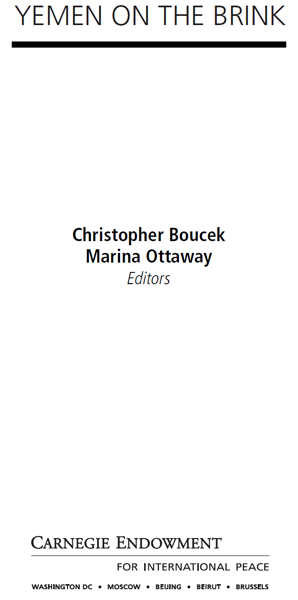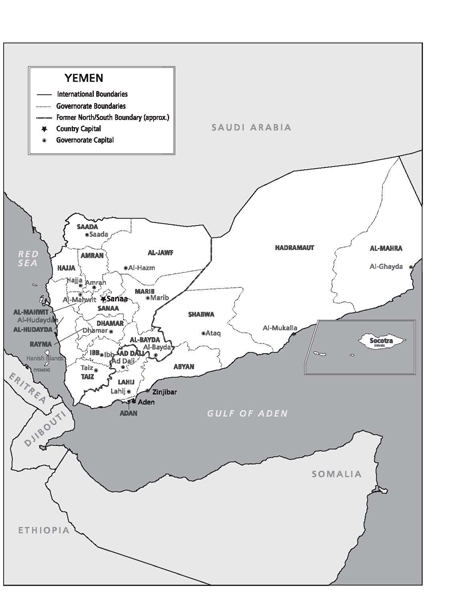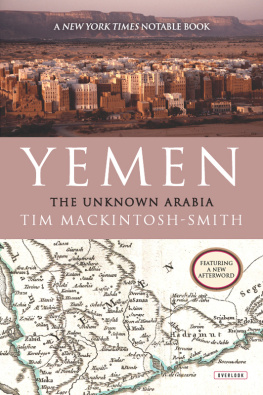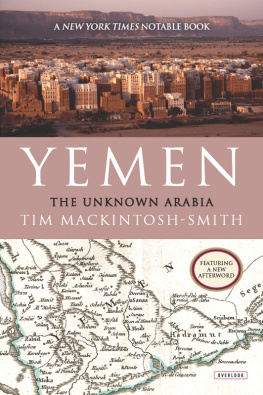Boucek Christopher - Yemen on the Brink
Here you can read online Boucek Christopher - Yemen on the Brink full text of the book (entire story) in english for free. Download pdf and epub, get meaning, cover and reviews about this ebook. City: Washington;D.C;Yemen (Republic, year: 2010;2012, publisher: Perseus Books, LLC;Carnegie Endowment for International Peace, genre: Politics. Description of the work, (preface) as well as reviews are available. Best literature library LitArk.com created for fans of good reading and offers a wide selection of genres:
Romance novel
Science fiction
Adventure
Detective
Science
History
Home and family
Prose
Art
Politics
Computer
Non-fiction
Religion
Business
Children
Humor
Choose a favorite category and find really read worthwhile books. Enjoy immersion in the world of imagination, feel the emotions of the characters or learn something new for yourself, make an fascinating discovery.
- Book:Yemen on the Brink
- Author:
- Publisher:Perseus Books, LLC;Carnegie Endowment for International Peace
- Genre:
- Year:2010;2012
- City:Washington;D.C;Yemen (Republic
- Rating:3 / 5
- Favourites:Add to favourites
- Your mark:
- 60
- 1
- 2
- 3
- 4
- 5
Yemen on the Brink: summary, description and annotation
We offer to read an annotation, description, summary or preface (depends on what the author of the book "Yemen on the Brink" wrote himself). If you haven't found the necessary information about the book — write in the comments, we will try to find it.
Yemen on the Brink — read online for free the complete book (whole text) full work
Below is the text of the book, divided by pages. System saving the place of the last page read, allows you to conveniently read the book "Yemen on the Brink" online for free, without having to search again every time where you left off. Put a bookmark, and you can go to the page where you finished reading at any time.
Font size:
Interval:
Bookmark:

2010 Carnegie Endowment for International Peace
All rights reserved. No part of this publication may be reproduced or transmitted in any form or by any means without permission in writing from the Carnegie Endowment.
Carnegie Endowment for International Peace
1779 Massachusetts Avenue, N.W., Washington, D.C. 20036
202-483-7600 www.ceip.org
The Carnegie Endowment does not take institutional positions on public policy issues; the views represented here are the authors own and do not necessarily reflect the views of the Endowment, its staff, or its trustees.
To order, contact Carnegies distributor:
Hopkins Fulfillment Service
PO Box 50370, Baltimore, MD 21211-4370
1-800-537-5487 or 1-410-516-6956
Fax: 1-410-516-6998
Library of Congress Cataloging-in-Publication Data
Yemen on the brink/Christopher Boucek and Marina Ottaway, editors.
p. cm.
Includes index.
ISBN 978-0-87003-253-0 (pbk.) ISBN 978-0-87003-254-7 (cloth) ISBN 978-0-87003-329-2 (e-book) 1. Yemen (Republic)Politics and government. 2. Political violenceYemen (Republic) 3. Islamic fundamentalismYemen (Republic) 4. Qaida (Organization) I. Boucek, Christopher. II. Ottaway, Marina.
JQ1842.A58Y46 2010
953.3053dc22 2010017143
Cover design by Zeena Feldman
CONTENTS
Jessica T. Mathews
Christopher Boucek
Alistair Harris
Christopher Boucek
Stephen Day
Sarah Phillips
Marina Ottaway and Christopher Boucek

Y emen faces an alarming confluence of challenges to its stability and that of its neighbors, and poses a real threat to the security of countries as far away as the United States. Dire economic circumstances, including poverty, unemployment, inflation, and the depletion of natural resources are compounded by the countrys addiction to qata widely produced and consumed stimulantas well as the serious security threats of smuggling, religious and tribal conflict, terrorism, and war. Yemen has them all.
This volume presents groundbreaking new analysis of Yemens most pressing concerns, for the benefit of Western policy makers and other readers who recognize how dramatically the countrys condition could affect them if it continues to deteriorate. Christopher Boucek, who warned of the countrys dangerous downward spiral in September 2009, provides a broad overview of Yemens deterioration and examines in detail the six rounds of fighting in Saada province. Sarah Phillips explores Yemens tribal dynamics and the limits of foreign intervention in the countrys problems. Stephen Day assesses the southern secessionist movement and support for al-Qaeda in the Arabian Peninsula (AQAP). Alistair Harris provides insights into whether the Yemeni regime can address the grievances articulated and tapped into by AQAP. In the Boucek and coauthor Marina Ottaway reflect on the options available to the international community to help stabilize the country.
The Republic of Yemen is strategically located between Saudi Arabia and Somaliapart of two distinct, yet interconnected regions, the Arabian Peninsula and the Horn of Africa. Though the country has been excluded from the wealthy Gulf Cooperation Council, it is in many ways more able to withstand multiple challenges than its East African neighbors. More than 3 million barrels of oil pass Yemens coast every day, through treacherous waters where Islamist terrorists and Somali pirates have staged many successful maritime attacks disrupting international commerce and the flow of vital hydrocarbons.
Inside Yemen, Islamist terrorists threaten Yemens domestic security, in the form of a resurgent al-Qaeda organization, as do an increasingly active secessionist movement in the South, and the armed insurrection in the North. While Yemen has survived crises in the past, they have tended to be singular events. The many problems Yemen now suffers are unprecedented in range and scope, and a historical absence of much central control makes it even more difficult to build effective national government.
As severe as these security challenges are, at the heart of Yemens problems is a looming economic crisis. The country is the poorest in the Arab world, its oil reserves are fast running out, and it has few viable options for a sustainable post-oil economy. Moreover, it is consuming its limited water resources much faster than it can replenish them. An impoverished and rapidly expanding population places unbearable pressure on the government, which can scarcely provide basic services. The faltering economy and poorly prepared workforce have pushed unemployment to 35 percent, on par with the Great Depression in the United States. Even for those who find work, poverty remains severe. The country has an annual per capita income of under $900, and nearly half the population earns less than $2 per day.
Yemen also confronts staggering demographic challenges. Though the population growth rate has decreased slightly in the past decade, it remains among the highest in the world, at just over 3.4 percent per year. As a result, more than two-thirds of the Yemeni people are under the age of 24, more than half of them illiterate. In the next two decades, Yemeni and Western analysts expect the countrys population to nearly double to more than 40 million.
The difficult terrain and geographic dispersion of the population exacerbate the demographic challenges. Yemens 23 million people are spread throughout roughly 135,000 villages and settlements. Many Yemeni villages are remote, spread across mountainsides and desert wadis, with less than one-third of the population living in urban areas. The central government has been unable to extend either a government presence or more than the most basic social services to its people. As a result, many settlements are forced to provide their own health care, schools, and other social services. The central government already struggles to exert control throughout the country, and its situation will only worsen as time passes.
In short, Yemen embodies a perfect storm of domestic and international challenges, and while they are all interrelated, any useful analysisthe starting point for addressing themmust break them down into manageable chunks. This book is a valuable start.
Jessica T. Mathews
President, Carnegie Endowment for International Peace
Christopher Boucek
Y emen is beset by a host of challenges that endanger both its domestic stability and regional security. The United States and the international community must act now, before conditions deteriorate further, to help Yemen meet these challenges. While Yemen has survived crises in the past, they have tended to be singular events, while the many problems it now faces are unprecedented in range and scope.
The problems include international terrorism, violent extremism, religious and tribal conflict, separatism, and transnational smuggling. Attempts to build effective national governance are frustrated by porous borders, a heavily armed population, and a historical absence of much central government control. Between Saudi Arabia and Somalia, Yemen is strategically locatedpart of two different yet interconnected regions, the Arabian Peninsula and the Horn of Africa. This fact often frustrates policy analyses; Yemen is excluded from the wealthy Gulf Cooperation Council, but is in many ways more resilient than its East African neighbors. More than 3 million barrels of oil pass through the treacherous waters off the countrys coast every day. The constant risk of attack by Islamist terrorists and Somali pirates threatens to disrupt the flow of vital hydrocarbons and international commerce more broadly.
Next pageFont size:
Interval:
Bookmark:
Similar books «Yemen on the Brink»
Look at similar books to Yemen on the Brink. We have selected literature similar in name and meaning in the hope of providing readers with more options to find new, interesting, not yet read works.
Discussion, reviews of the book Yemen on the Brink and just readers' own opinions. Leave your comments, write what you think about the work, its meaning or the main characters. Specify what exactly you liked and what you didn't like, and why you think so.











